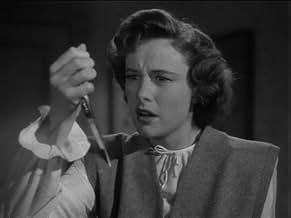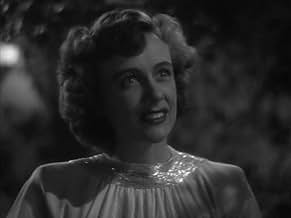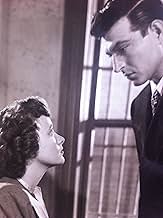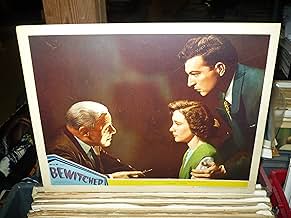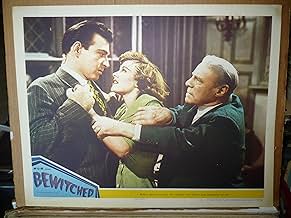Aggiungi una trama nella tua linguaA young woman has two distinct personalities, one of whom is evil and constantly gets her in trouble.A young woman has two distinct personalities, one of whom is evil and constantly gets her in trouble.A young woman has two distinct personalities, one of whom is evil and constantly gets her in trouble.
Stephen McNally
- Eric Russell
- (as Horace McNally)
Tom Coleman
- Juror
- (non citato nei titoli originali)
Clancy Cooper
- Cop
- (non citato nei titoli originali)
Eddie Dunn
- Prison Janitor
- (non citato nei titoli originali)
George Meader
- Juror
- (non citato nei titoli originali)
Howard M. Mitchell
- Juror
- (non citato nei titoli originali)
Recensioni in evidenza
This is a bold film for its time because it tackles mental illness head on - in this case multiple personality syndrome. Thaxter is quite good as the sweet young girl occasionally taken over by the evil Karin (voiced brilliantly by Audrey Totter). Unfortunately the director takes it all far too seriously, and his constant cut-aways to grim or shocked reaction shots becomes comical. You really feel for the actors. Thank God for the wonderful Edmund Gwenn, who is the only actor who makes the material almost believable. And what a great psychiatrist he is - he can cure multiple personality syndrome in a matter of seconds, just by talking sternly to the evil side! Some nice visual moments and the uniqueness of the material make this film worth a look.
No need to repeat the plot. The force behind the movie is Arch Oboler, an established radio heavyweight at the time. From his credits, it looks like he kept searching for a handle in Hollywood but never quite found it. Certainly, it wasn't from lack of imagination—his 1951 film "Five" dealt with nuclear post-apocalypse in a resourceful and compelling way at a time when no studio would touch the subject. That same bold imagination is evident in this movie as well. The professionals dismiss the film as "heavy-handed", which it is. However, there are compensations that are too easily overlooked.
Aside from Thaxter's fine performance, the movie contains several profoundly imaginative touches. Catch that moody dollying shot down the deserted city street that finally fixes on a cringing Thaxter hiding behind an open doorway. Not only is it great atmosphere, but it also sort of sums up Thaxter's predicament. She's afraid to come out into the world for risk of immediate exposure, so she clings fearfully to a hidden world where only she exists. It's a well-conceived and artfully executed passage. Then there's that darn-near sublime set-up with Thaxter huddled in a concert hallway while we see a long-shot of a vocalist pinpointed by a thin beam of light. The woman intones a mournful version of My Old Kentucky Home, like the proverbial voice in the darkened wilderness. It may be the only glimpse we get of Thaxter's true inner self, summed up poetically.
But the overly literal side does unfortunately predominate, and I wish someone had more confidence in audience imagination. For one thing, that would have eliminated the two hokey doppelgangers in the exorcism scene. Also, the conventional happy ending is much too pat for the problem being dealt with, but is indicative of the time. And if I'm not mistaken, there's a quick reference from Gwenn to Thaxter's problem as being genetic, as if a multiple personality trait can be passed along in the genes. I'm no clinical psychologist, but I doubt seriously this is the prevailing view. Anyway, it's too bad Oboler couldn't get a better handle on Hollywood. I think his credits showed genuine promise. This movie may be unfortunately flawed (perhaps because of studio dictates), but the very real compensations should not be overlooked.
Aside from Thaxter's fine performance, the movie contains several profoundly imaginative touches. Catch that moody dollying shot down the deserted city street that finally fixes on a cringing Thaxter hiding behind an open doorway. Not only is it great atmosphere, but it also sort of sums up Thaxter's predicament. She's afraid to come out into the world for risk of immediate exposure, so she clings fearfully to a hidden world where only she exists. It's a well-conceived and artfully executed passage. Then there's that darn-near sublime set-up with Thaxter huddled in a concert hallway while we see a long-shot of a vocalist pinpointed by a thin beam of light. The woman intones a mournful version of My Old Kentucky Home, like the proverbial voice in the darkened wilderness. It may be the only glimpse we get of Thaxter's true inner self, summed up poetically.
But the overly literal side does unfortunately predominate, and I wish someone had more confidence in audience imagination. For one thing, that would have eliminated the two hokey doppelgangers in the exorcism scene. Also, the conventional happy ending is much too pat for the problem being dealt with, but is indicative of the time. And if I'm not mistaken, there's a quick reference from Gwenn to Thaxter's problem as being genetic, as if a multiple personality trait can be passed along in the genes. I'm no clinical psychologist, but I doubt seriously this is the prevailing view. Anyway, it's too bad Oboler couldn't get a better handle on Hollywood. I think his credits showed genuine promise. This movie may be unfortunately flawed (perhaps because of studio dictates), but the very real compensations should not be overlooked.
When I saw this excellent little B thriller, I could not prevent me to think of THREE FACES OF EVE, the Nunnaly Johnson's masterpiece. Very close plot, topic, but this one is unfortunately unknown, underrated, except maybe for the die hard moviegoers. It is a Metro Goldwyn Mayer's movie - at least for the release - and the lead character played by Phillis Thaxter is absolutely perfect in this very difficult role of this young woman suffering of a multiple personality disorder. But both features are quite different though, this one is more eerie and less complex in the psychological, psychoanalytic than the movie starring Joanne Woodward. Arch Oboler leaves here his trade mark, making something different, offbeat. A cute little gem.
Prototype Film-Noir from Stylist Arch Oboler who made His Name on the Radio with His Ultra-Popular "Lights Out" Program. Here He Adopts His Own Story "Alter-Ego" and brings it to the Screen for MGM.
This is One of the Few MGM Noirs of the First Wave. It would Take Years before the Haughty Studio would lend its Name Seriously to a Style so Dark.
Phyllis Thaxter gives a Good Performance in a Soul-Baring Role. Steve McNally is Miscast but manages to look Desperate and Edmund Gwenn as the Psychiatrist trying to Exorcise Thaxter's other Personality, the Evil One, is a Good Try.
With its Roots in Dr. Jekyll and Mr. Hyde, the only Reference Point at this Point for Multiple Personalities On Screen, Oboler delivers and Ultra-Stylish Descent into Schizophrenia.
The Film is Guilty of way too Much Verbiage, a Radio Drama influence, but it Balances it with Film Flourishes that are Atmospheric and Stunning.
The Movie Grips the Audience as it tries to Explain and Expose Psychiatric Methods and Procedures. But the Truth is that Not Much was Known at the Time and the Little that was Known was constantly Up for Debate in the Medical Community.
So it was No Easy Task Transferring this to the Movies. For Years Hollywood gave it a go with Extremely Inconsistent Results. It Was a Staple in Film-Noir and the Horror of Val Lewton but Main Stream and "A" Pictures were Reluctant to take it on for quite Some Time.
Overall, this is a Great Early Effort and a Striking Example of Film-Noir and the Psychological Pictures that Started a Run After the War and Never Stopped, and actually becoming a Genre of its own (The Psychological Thriller).
This is One of the Few MGM Noirs of the First Wave. It would Take Years before the Haughty Studio would lend its Name Seriously to a Style so Dark.
Phyllis Thaxter gives a Good Performance in a Soul-Baring Role. Steve McNally is Miscast but manages to look Desperate and Edmund Gwenn as the Psychiatrist trying to Exorcise Thaxter's other Personality, the Evil One, is a Good Try.
With its Roots in Dr. Jekyll and Mr. Hyde, the only Reference Point at this Point for Multiple Personalities On Screen, Oboler delivers and Ultra-Stylish Descent into Schizophrenia.
The Film is Guilty of way too Much Verbiage, a Radio Drama influence, but it Balances it with Film Flourishes that are Atmospheric and Stunning.
The Movie Grips the Audience as it tries to Explain and Expose Psychiatric Methods and Procedures. But the Truth is that Not Much was Known at the Time and the Little that was Known was constantly Up for Debate in the Medical Community.
So it was No Easy Task Transferring this to the Movies. For Years Hollywood gave it a go with Extremely Inconsistent Results. It Was a Staple in Film-Noir and the Horror of Val Lewton but Main Stream and "A" Pictures were Reluctant to take it on for quite Some Time.
Overall, this is a Great Early Effort and a Striking Example of Film-Noir and the Psychological Pictures that Started a Run After the War and Never Stopped, and actually becoming a Genre of its own (The Psychological Thriller).
Bewitched is written and directed by Arch Oboler. It stars Phyllis Thaxter, Edmund Gwenn, Henry H. Daniels, Addison Richards, Horace McNally and Kathleen Lockhart. Music is by Bronislau Kaper and cinematography by Charles Salerno Jr.
One of the most interesting of splinters to come out of film noir was that which dealt with psychoanalysis. Be it mentally scarred war veterans, amnesia sufferers with locked in repression, or a victim being pushed to the mental abyss by an outside force, the state of mind factor was ripe for any sort of film noir sheen.
What was under represented were films that dealt with mental illness' like schizophrenia or multiple (split) personalities. History tells us that Hollywood took a long time to get to grips with such topics, very much resorting to guesswork (and sometimes laughable) solutions to mental health issues just to close out the movies with a happy outcome.
It would take until 1957 and Three Faces of Eve (and to a lesser extent Hugo Haas' Lizzie released the same year) for the personality disorder issue to break out of Hollywood and into the public conscious. But even then with "Eve", if you take out Joanne Woodward's spell binding performance you are left with some mumbo-jumbo and a daft resolution to the curing of the patient.
So where does this leave Bewitched in 1945? Transferred from radio to the big screen by Oboler, from his own story titled Alter Ego, Bewitched suffers from the same simplified problems of so many like minded sub-genre movies, in that the resolution ("cure") is just so hard to get on board with. However...
If allowing the film some grace for the time it was made, then there's a very good picture here. Clocking in at just over an hour, it certainly feels and plays like one of those extended episodes of The Twilight Zone from Season 4, but the atmospherics and lead performances of cast members ensure this is fascinating and suspenseful entertainment.
Plot essentially sees Thaxter as troubled Joan Alris Ellis, who after starting to hear a sinister voice in her head (voiced by noir darling Audrey Totter), flees to New York to start afresh, leaving behind family and her intended husband to be. After becoming involved in a warm relationship with Eric Russell (McNally), Joan finds that the voice, her alter ego, is not going to go away and urges Joan to commit murder.
Pic unfolds in a flashback structure, Joan is awaiting execution and we learn how she came to be in this situation. Oboler and Salerno film the piece through a film noir prism, ensuring that a disquiet mood is prevalent throughout. As the lens' mist up and shadows fall (99% of film is set in darkness or daylight as darkness), the visuals marry up nicely with poor Joan's befuddlement.
Oboler is guilty of letting the piece meander at times, as it often becomes over talky (the radio origins practically scream from the speakers!), but he has a very sharp eye for an evocative scene, and he's also capable of telling tech flourishes. Joan running down a street lit by bulbous lamps is straight out of noirville, distorted angles come and go, and clocks feature prominently, like Old Nick is right there counting down the seconds on every clock face.
Then it's that resolution. Simplified for sure, but not without eeriness personified as Joan's femme fatale alter ego arrives on the scene in a clear case of angel and demon perched on either side of the hapless patient. With Thaxter excelling with her haunted portrayal, Gwenn exuding assurance unbound, and Kaper (Gaslight) drifting a creeping menace like musical score over the proceedings, the impact garnered belies the "B" budget afforded the play. 7.5/10
One of the most interesting of splinters to come out of film noir was that which dealt with psychoanalysis. Be it mentally scarred war veterans, amnesia sufferers with locked in repression, or a victim being pushed to the mental abyss by an outside force, the state of mind factor was ripe for any sort of film noir sheen.
What was under represented were films that dealt with mental illness' like schizophrenia or multiple (split) personalities. History tells us that Hollywood took a long time to get to grips with such topics, very much resorting to guesswork (and sometimes laughable) solutions to mental health issues just to close out the movies with a happy outcome.
It would take until 1957 and Three Faces of Eve (and to a lesser extent Hugo Haas' Lizzie released the same year) for the personality disorder issue to break out of Hollywood and into the public conscious. But even then with "Eve", if you take out Joanne Woodward's spell binding performance you are left with some mumbo-jumbo and a daft resolution to the curing of the patient.
So where does this leave Bewitched in 1945? Transferred from radio to the big screen by Oboler, from his own story titled Alter Ego, Bewitched suffers from the same simplified problems of so many like minded sub-genre movies, in that the resolution ("cure") is just so hard to get on board with. However...
If allowing the film some grace for the time it was made, then there's a very good picture here. Clocking in at just over an hour, it certainly feels and plays like one of those extended episodes of The Twilight Zone from Season 4, but the atmospherics and lead performances of cast members ensure this is fascinating and suspenseful entertainment.
Plot essentially sees Thaxter as troubled Joan Alris Ellis, who after starting to hear a sinister voice in her head (voiced by noir darling Audrey Totter), flees to New York to start afresh, leaving behind family and her intended husband to be. After becoming involved in a warm relationship with Eric Russell (McNally), Joan finds that the voice, her alter ego, is not going to go away and urges Joan to commit murder.
Pic unfolds in a flashback structure, Joan is awaiting execution and we learn how she came to be in this situation. Oboler and Salerno film the piece through a film noir prism, ensuring that a disquiet mood is prevalent throughout. As the lens' mist up and shadows fall (99% of film is set in darkness or daylight as darkness), the visuals marry up nicely with poor Joan's befuddlement.
Oboler is guilty of letting the piece meander at times, as it often becomes over talky (the radio origins practically scream from the speakers!), but he has a very sharp eye for an evocative scene, and he's also capable of telling tech flourishes. Joan running down a street lit by bulbous lamps is straight out of noirville, distorted angles come and go, and clocks feature prominently, like Old Nick is right there counting down the seconds on every clock face.
Then it's that resolution. Simplified for sure, but not without eeriness personified as Joan's femme fatale alter ego arrives on the scene in a clear case of angel and demon perched on either side of the hapless patient. With Thaxter excelling with her haunted portrayal, Gwenn exuding assurance unbound, and Kaper (Gaslight) drifting a creeping menace like musical score over the proceedings, the impact garnered belies the "B" budget afforded the play. 7.5/10
Lo sapevi?
- QuizAudrey Totter dubbed Thaxter's evil personality's voice.
- Citazioni
Joan Alris Ellis: Bob, do you hear... someone talking?
- ConnessioniFeatured in The Late, Late Show: Bewitched (1962)
I più visti
Accedi per valutare e creare un elenco di titoli salvati per ottenere consigli personalizzati
Dettagli
- Tempo di esecuzione1 ora 5 minuti
- Colore
- Proporzioni
- 1.37 : 1
Contribuisci a questa pagina
Suggerisci una modifica o aggiungi i contenuti mancanti

Divario superiore
By what name was Demone bianco (1945) officially released in India in English?
Rispondi


